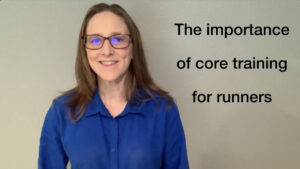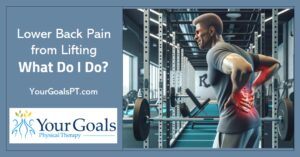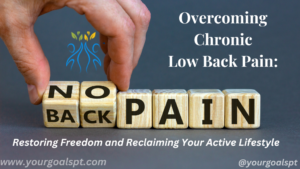Chronic lower back pain caused by overuse or Repetitive Strain Injuries is quite common. Most cases of lower back pain occur due to overuse that develops from our daily activities and postures — especially repetitive activities.
The Multifidus and Erector Spinea muscles play a role in extending the spine. To put it differently, functionally, they resist excessive spinal flexion exerted on the spine by the abdominal muscles.
These muscles were not designed for the way we use them in our daily lives. For instance, they are used when we spend hours sitting in a hunched position, whether it’s for working at a computer, watching Netflix, or using our phones – and no one would think they are using their back muscles during these activities.
So, what do you do to help your back heal? Let’s examine everything, from the cause of the pain and common symptoms to 6 things you can do to recover without pain medications:
We will start with What Activities Lead to Repetitive Strain Injuries in the Lower Back?
Slouching, sitting in a hunched position, and using your back to bear loads — plus bending or twisting while using your back to bear loads.
Back muscles also weren’t created to be the primary muscle for lifting or moving things across the room. Hip muscles are meant to be the primary muscles during those movements, while the Erectors Spinea, Multifidus, and abdominal muscles are there to stabilize the spine.
That’s why repeated movements or sustained poor posture eventually lead to stress on these regions, causing the spine’s misalignment. Over time, these repetitive forces provoke an inflammatory response, contributing to significant strain and possibly, nerve compression or instability.
To go into more detail about how Poor Posture stresses your back…
Slouching or leaning forward causes the spine to shift out of its natural alignment, placing undue stress on the muscles and ligaments surrounding the back.
By maintaining a posture that has your ears over your shoulders, shoulders over hips and hips over ankles, you lower the required strength of your trunk muscle especially your lower back muscles.
For instance, if you have an increased curve in your thoracic spine, then upper back muscles are stretched past their anatomical or “normal” position.
To compensate for the change in a spinal curve in the upper spine, the curve in the lower spine will also change.
If the lower back reverses its normal curve then the erector spinae and multifidus will be stretched compared to their normal position. If the lower back increases the curve (increases the lordosis) then the erector spinae and multifidus will be placed in a shortened position. Over time both these positions will reduce the strength of these muscles.
These spine alignment changes can be complicated by a phenomenon known as tissue creep. Placing a tissue in a stretched position for a long time causes tissue creep, which changes the natural length and strength of the tissue. Basically, that tissue becomes less able to tolerate the daily stresses placed on it.
I will leave links for you to get Tips for an ergonomic workstation and furniture that can help correct back posture
Let’s talk a little more about the symptoms of recurring lower back pain…
A common story is that pain started after their workout, but then it would go away. The pain acted weirdly. It would be mild at the start of a workout, then go away in the middle, only to return after the workout. Eventually, the pain would affect everyday activities.
Clients have reported having strong ache in their lower back after sitting for long periods, after standing for long periods of time, with bending down to pick something up, or even doing basic household tasks like dishes.
Walking is typically okay to start, but then the pain can limit how far they want to walk. In many cases these simple daily tasks would change the strong aching pain pain to a sharp jabbing pain.
The pain becomes too much to work through, they not only stop working out but they limit all activities for a week or two. Unfortunately, even if their pain went away, many times it only lessened after the two-week break, when they returned to their normal activities, the pain returned.
What can you do to help recur lower back pain?
Thankfully our bodies are designed for motion. The spine is designed to flex, extend, side bend and rotate all without pain. Just because you have lower back pain today does not mean you have to have lower back pain for the rest of your life.
My patients find permanent relief through hands-on techniques, prescribed exercises to correct strength imbalances, improving their work station set ups, and improving their mechanics with functional (daily) activities.
If you are suffering from lower back muscle strain or overuse injury, here are 5 things you can start doing today to heal your lower back pain:
1. Icing for Back Strain
Icing is a great method to reduce swelling in overused muscles by constricting blood flow and disrupting the body’s inflammation process.
I know that everyone always says ice or heat injuries and it might sound like a throwaway piece of advice. But I have had clients call me in acute pain that dramatically changed after laying down for 10 minutes with ice.
Watch this video for a suggested set up:
Icing can be particularly beneficial for managing symptoms associated with overuse injuries and muscle spasms. By addressing inflammation and promoting healing in the ligaments and tendons, patients with conditions like a lumbar strain injury may find relief and improved function as back strains heal.
2. Massage for Back Pain from Strain Injuries
One issue for overused muscles is they lack sufficient time to heal. The muscle fibers end up crossed instead of in a straight line because of the extended inflammation process and hurried elastin production. Through massage, fibers can be re-aligned to improve strength and endurance.
By simply rubbing your fingers horizontally across the muscle fibers, you reduce pain, inflammation and the function of your lower back muscles.
3. Stretching for Back Pain
Similar to massage, gentle stretching can help an overused muscle regain its normal length and reduce pain with contraction.
Try these lower body stretches, in addition to your favorite hamstring, hip flexor and quad stretches:
Double Knee to Chest Stretch Modifications
Child’s Pose Stretch Modifications
Gentle stretching is particularly beneficial for easing muscle tension and alleviating symptoms from back pain, including those caused by lower body strain.
Engaging in repetitive movements, especially those that involve sudden twisting or prolonged compression, can increase the risk of a spinal strain injury.
Addressing tight hamstrings and hip flexors and ensuring proper spinal alignment can significantly improve the overall health of the lumbar region and help prevent common back injuries.
4. Strengthening
It’s highly important to strengthen overused muscles. But you have to start off with gentle strengthening. The trick to healing an overused muscle is to strengthen the muscle just up to the point of discomfort. This is not the time to push through pain.
With a lower back strain, it is equally important to strengthen the surrounding muscles for quick and lasting recovery. A well-rounded strength program should be introduced to address any muscle imbalances in the torso and hips.
To foster healing in injured muscles, it’s crucial to recognize that many overuse injuries stem from repetitively straining the erector spinae or multifidus past their strength or endurance tolerance.
By implementing a structured strengthening program, one can help restore proper lower back curvature, alleviating residual compression and promoting overall spinal health.
5. Improve Your Posture
Maintaining proper posture can significantly diminish the risk of chronic pain, as it helps prevent damaging the vertebra or the intervertebral disc and surrounding tissue.
Practicing good posture can lead to decreased pain from back sprains and other injuries, promoting faster and more effective healing.
To get started, you can simply practice good standing posture during a normal part of your daily routine. For instance, at the gym while surrounded by mirrors or while you do your dishes, or on your daily walks, pay attention to if your shoulders are slouching or if your head is forward.
If you work long hours at a computer changing the ergonomics of your workspace can help you maintain proper posture. For many people, it might mean getting a taller chair, or adjusting a monitor height.
Over time, you will be more aware of your posture throughout the day, allowing you to make adjustments without having to concentrate on your posture all day.
6. Personalized Guidance from a Physical Therapist for Back Pain
Fast track your recovery by talking to a physical therapist who specializes in identifying the underlying cause of low back pain or overuse in active adults.
Trying to find the best way to relieve pain and resume your favorite activities can be overwhelming when dealing with overuse or muscle strain injuries. At Your Goals Physical Therapy, we help active adults end their lower back pain, so they can reclaim their favorite recreational activities and live life to the fullest.
To address the pain, we first determine its root cause and provide relief. Then, through specialized hands-on techniques and strengthening activities, we restore the muscle’s healing and strength. Lastly, we enhance muscle strength and resilience to prevent future injuries.
The entire way, all exercises and activities are prescribed to not prolong symptoms and avoid side effects.
If you are tired of just managing your lower back pain and you are ready to get started today, click the button below labeled “ask about cost & availability” to fill out a simple form that allows us to contact you.
If you have questions about your specific situation, whether you are not sure if physical therapy is the right treatment for you or you wonder if it would be any different from your last experience. Click the button “Talk to a PT“, we will be happy to help contact you to set up a 20 minute chat with a physical therapist to make sure we are the right fit for you.







